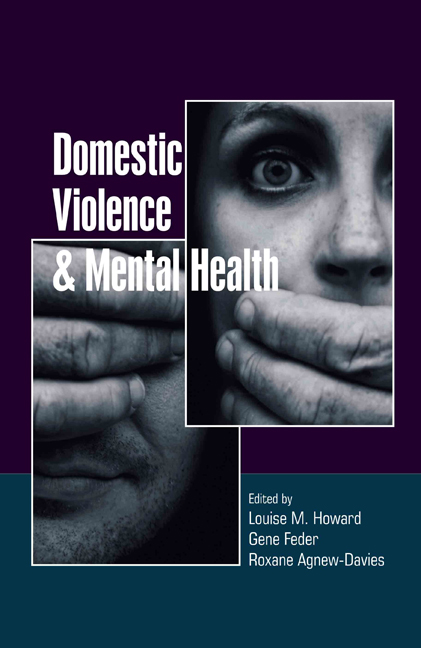Book contents
- Frontmatter
- Contents
- List of tables, boxes and figures
- List of contributors
- 1 Prevalence and physical health impact of domestic violence
- 2 Domestic violence and mental health
- 3 Identifying domestic violence experienced by mental health service users
- 4 Responding to disclosures of domestic violence
- 5 Interventions for mental health service users who experience domestic violence
- 6 Medico-legal issues
- Appendix 1 CAADA Risk Identification Checklist (RIC) and Quick Start Guidance for Domestic Abuse, Stalking and ‘Honour’-Based Violence
- Appendix 2 Domestic violence resources and directory of services
- Index
1 - Prevalence and physical health impact of domestic violence
- Frontmatter
- Contents
- List of tables, boxes and figures
- List of contributors
- 1 Prevalence and physical health impact of domestic violence
- 2 Domestic violence and mental health
- 3 Identifying domestic violence experienced by mental health service users
- 4 Responding to disclosures of domestic violence
- 5 Interventions for mental health service users who experience domestic violence
- 6 Medico-legal issues
- Appendix 1 CAADA Risk Identification Checklist (RIC) and Quick Start Guidance for Domestic Abuse, Stalking and ‘Honour’-Based Violence
- Appendix 2 Domestic violence resources and directory of services
- Index
Summary
Domestic violence and abuse is threatening behaviour, violence or abuse between adults who are relatives, partners or ex-partners. It includes abuse from adult children and from parents of adult children. Domestic violence is a breach of human rights as well as a major public health and clinical problem. In this chapter we focus largely on violence between partners or ex-partners when discussing prevalence, and exclusively on partner violence when reviewing evidence on the health impact of domestic violence and abuse, as this is the focus of most research to date.
Definition of intimate partner violence
Intimate partner violence is a form of domestic violence occurring between intimate partners or ex-partners. Whereas violence between partners occurs in all types of relationships and cuts across all sections of society, intimate partner violence is recognised as a gendered issue where women are overwhelmingly more likely to be injured as a result of violence, require medical attention or hospital admission, and fear for their lives, and men are more likely to perpetrate violence. Internationally, there are no consistent demographic associations with intimate partner violence, such as ethnicity, age and number of children, other than relative poverty. Although it is prevalent across the socioeconomic spectrum, intimate partner violence is more common in families and communities which are relatively deprived (Pickett & Wilkinson, 2009). In the UK, the USA and Canada, younger women (aged between 16 and 34) experience the highest rates of intimate partner violence (Smith et al, 2011; Catalano, 2012; Sinha, 2012) and there is some evidence that women with disabilities are at increased risk (Mirlees-Black, 1999).
In earlier decades, terms such as wife abuse, conjugal violence and spousal abuse were commonplace, but they have been superseded by more general terms, such as domestic violence, in recognition that violence and abuse does not just occur between married couples. In the UK, domestic violence has a precise definition denoting violence between adults who are relatives, partners or ex-partners (Home Office, 2012). Intimate partner violence specifically refers to abuse from partners or ex-partners, distinguishing it from other forms of violence that may occur in a family or domestic setting.
- Type
- Chapter
- Information
- Domestic Violence and Mental Health , pp. 1 - 17Publisher: Royal College of PsychiatristsFirst published in: 2017

